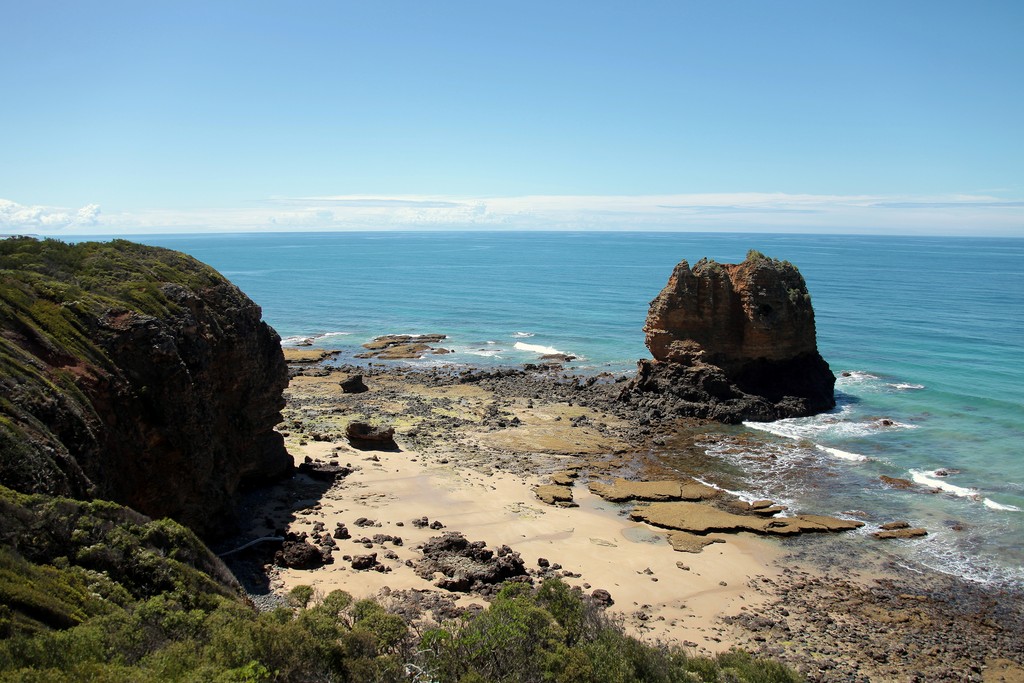SUNNY DAY
La Great Ocean Road est une route côtière de 243 km longeant l'État de Victoria, situé sur la côte sud-est en Australie entre les villes de Torquay et de Allansford. Construite entre 1919 et 1932 par des soldats revenus de la Première Guerre mondiale, cette route est devenue un haut lieu touristique du Victoria. Elle offre de magnifiques vues du détroit de Bass avec des paysages faits de falaises et autres formations rocheuses impressionnantes, telles que le Loch Ard Gorge, le Grotto, le London Bridge (renommé London Arch depuis l'effondrement d'un de ses segments) et surtout les fameux Douze Apôtres (Twelve Apostles). Elle est aussi bordée par la plage de Torquay, mondialement réputée pour le surf. Elle fait partie de la Australian National Heritage List depuis le 7 avril 2011.
Chaque année, la Great Ocean Road attire plus de 8 millions de touristes et génère un revenu annuel d’1,5 milliard de dollars.
---------------------------------------------
The Great Ocean Road is an Australian National Heritage listed 243 kilometres (151 mi) stretch of road along the south-eastern coast of Australia between the Victorian cities of Torquay and Allansford. Built by returned soldiers between 1919 and 1932 and dedicated to soldiers killed during World War I, the road is the world's largest war memorial. Winding through varying terrain along the coast and providing access to several prominent landmarks, including the Twelve Apostles limestone stack formations, the road is an important tourist attraction in the region.
The Great Ocean Road officially starts at Torquay and travels 244 kilometres westward to finish at Allansford near Warrnambool, the largest city along the road. The road is two lane (one in each direction), and is covered by a speed limit changing between 80 kilometres per hour and 100 kilometres per hour.
The road is considered a tourist attraction in the area, in which much of the road hugs coastline affectionately known as the Surf Coast between Torquay and Cape Otway and the Shipwreck Coast further west of Cape Otway, providing visibility of Bass Strait and the Southern Ocean. The road traverses rainforests, as well as beaches and cliffs composed of limestone and sandstone, which is susceptible to erosion. The road travels via Anglesea, Lorne, Apollo Bay, and Port Campbell, the latter being notable for its natural limestone and sandstone rock formations including Loch Ard Gorge, The Grotto, London Arch (formerly London Bridge) and The Twelve Apostles. At the stretch of the Great Ocean Road nearer to Geelong, the road meanders along the coast, with tall, almost-vertical cliffs on the other side of it. Road signs put up along the road warn motorists of possible rockfalls, which have occurred before.
The city of Geelong, close to Torquay, experiences great benefit from Australian and international visitors to the road; with Geelong Otway Tourism affirming it as an invaluable asset.[8][9] The Royal Automobile Club of Victoria (RACV) listed the road as the state's top tourism experience in its Victoria 101 survey, based on spots recommended by members and the public on what they would recommend to visitors. However, according to a survey performed by the Surf Coast Shire, residents have expressed concern that there are not enough safe crossings along the road.
Chaque année, la Great Ocean Road attire plus de 8 millions de touristes et génère un revenu annuel d’1,5 milliard de dollars.
---------------------------------------------
The Great Ocean Road is an Australian National Heritage listed 243 kilometres (151 mi) stretch of road along the south-eastern coast of Australia between the Victorian cities of Torquay and Allansford. Built by returned soldiers between 1919 and 1932 and dedicated to soldiers killed during World War I, the road is the world's largest war memorial. Winding through varying terrain along the coast and providing access to several prominent landmarks, including the Twelve Apostles limestone stack formations, the road is an important tourist attraction in the region.
The Great Ocean Road officially starts at Torquay and travels 244 kilometres westward to finish at Allansford near Warrnambool, the largest city along the road. The road is two lane (one in each direction), and is covered by a speed limit changing between 80 kilometres per hour and 100 kilometres per hour.
The road is considered a tourist attraction in the area, in which much of the road hugs coastline affectionately known as the Surf Coast between Torquay and Cape Otway and the Shipwreck Coast further west of Cape Otway, providing visibility of Bass Strait and the Southern Ocean. The road traverses rainforests, as well as beaches and cliffs composed of limestone and sandstone, which is susceptible to erosion. The road travels via Anglesea, Lorne, Apollo Bay, and Port Campbell, the latter being notable for its natural limestone and sandstone rock formations including Loch Ard Gorge, The Grotto, London Arch (formerly London Bridge) and The Twelve Apostles. At the stretch of the Great Ocean Road nearer to Geelong, the road meanders along the coast, with tall, almost-vertical cliffs on the other side of it. Road signs put up along the road warn motorists of possible rockfalls, which have occurred before.
The city of Geelong, close to Torquay, experiences great benefit from Australian and international visitors to the road; with Geelong Otway Tourism affirming it as an invaluable asset.[8][9] The Royal Automobile Club of Victoria (RACV) listed the road as the state's top tourism experience in its Victoria 101 survey, based on spots recommended by members and the public on what they would recommend to visitors. However, according to a survey performed by the Surf Coast Shire, residents have expressed concern that there are not enough safe crossings along the road.
